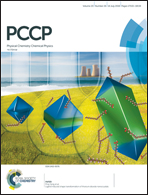A computationally-derived model for the solvatochromism of p-phenolates with high predictive power†
Abstract
We report that the positive, reverse or negative solvatochromism of p-phenolate-based dyes is highly correlated with the multireferential (MR) character of their ground-state wave function, with negative compounds presenting the highest degeneracy. CASSCF/NEVPT2 calculations show that the high MR character of the wave-function in negative dyes allows those systems to increase the dipole moment of the ground state by breaking the degeneracy as a response to the field of a polar solvent. The resulting stabilization of the ground-state with increasing solvent polarity leads to the observed negative solvatochromic behavior. A computational indicator based on our results has been successfully used for determining the direction of the solvatochromic shift of 24 dyes. Thus, our work sheds light on the physical–chemical basis for solvatochromism while providing experimental chemists with a practical tool for the design of novel negative, positive or reverse solvatochromic dyes.



 Please wait while we load your content...
Please wait while we load your content...